Design and Performance Analysis of New Ultra-Supercritical Double Reheat Coal-Fired Power Generation Systems
Abstract
1. Introduction
- (1)
- The low temperature feed water and the superheat heat of extraction steam are used to heat part of the air.
- (2)
- The mass flow rate of the flue gas required for the air preheater is reduced, and the remaining high temperature flue gas replaces part of high temperature steam extraction to heat both the condensate water and feed water, so as to increase the output power of steam turbine.
- (3)
- Compared with systems of other literatures, the superheat degrees of extraction steams and the temperature differences of the air heat transfer process are reduced together in the new system 1 and new system 2.
2. Description of Reference Double Reheat Cycle and Heat Transfer Process Analysis
3. New Boiler-Turbine Coupling System
3.1. Optimizing Methods
3.2. New Boiler-Turbine Coupling System
4. Calculation and Analysis of Thermal Performance
4.1. Model Simulation Design and Assumptions
- (1)
- The mass flow rate of live steam is 2533 t/h.
- (2)
- Regenerative steam extraction pressures and pipeline pressure drops at all levels are based on the thermal balance diagrams of the power plant.
- (3)
- The pressure drop coefficient of the 1st reheater and pipelines is 4.3%.
- (4)
- The pressure drop coefficient of the 2nd reheater and pipelines is 4.2%.
- (5)
- The absolute pressure drop of the boiler inlet feed water is 1.5 MPa.
- (1)
- In order to compare the variations of extraction steam at all pressure levels, the main steam mass flow of new system 1 at the design point is kept the same as that of the reference system.
- (2)
- The initial parameters are 30.1 MPa/600 °C/610 °C.
- (3)
- The condenser pressure is 4.5 kPa.
- (4)
- The pressure drop of each air heater at the air side is 0.2 kPa.
- (5)
- The pressure drop of each air heater drop at the steam side is 2 kPa.
- (6)
- The heat loss of the air heater is ignored.
- (7)
- Air outlet temperature of AH is 150 °C.
4.2. Analysis of Heat Transfer Performance of Tail Flue Gas in New Boiler-Turbine Coupling System
4.3. Exergy Utilization Diagram of the Air Preheating Subsystem
4.4. Analysis of Steam Extraction Mass Flow and Power Generation Capacity in Regenerative System
4.5. Analysis of Steam Extraction Mass Flow and Power Generation Capacity in Regenerative System
5. Off-Design Performance Analysis
6. Re-Optimization of New System 1
6.1. Energy-Saving Potential Analysis of New System 1
6.2. Analysis of Optimization Results
- (1)
- The outlet air temperature of AH is 100 °C.
- (2)
- Pressure drop values on both the water side and the air side of AH are 0.2 kPa.
- (3)
- The outlet air temperature of AH8 is 150 °C.
6.3. Variation of Steam Extraction at Different Levels in New System 3
6.4. Performance Analysis of New System 3
6.5. Off-Design Performance Analysis
7. Conclusions
- (1)
- The low temperature feed water and the superheat heat of extraction steam are used to heat part of the air in new system 1 and new system 2. The superheat degrees of extraction steams and the temperature differences of the air heat transfer process are reduced together.
- (2)
- New system 2 replaces two-stage outside steam coolers with the air heater on the basis of new system 1, and thermal performances of two systems are deeply compared.
- (3)
- New system 3 uses the feed water to preheat the air on the basis of new system 1, and the heat transfer temperature difference of air preheater is further reduced.
- (1)
- The new systems follow with the energy level matching principle. Through the boiler-turbine coupling, the exergy losses of heat transfer process are obviously reduced, and the thermal efficiency of the overall system are improved. The results show that the power output of new system 1 increases by 6.38 MW and the standard coal consumption rate decreases by 1.65 g/kWh compared with the reference system. The power output of new system 2 increases by 6.93 MW and the standard coal consumption rate decreases by 1.79 g/kWh compared with the reference system.
- (2)
- The performances of new system 1 and new system 2 are better than that of reference system under all working conditions. When the load decreases, the coal consumption rate of two new systems increases more slowly, and the inlet air temperature of boiler can be maintained to ensure the safe operation of the boiler. However, the exhaust temperatures of flue gas in two new systems are slightly lower than that of original system. When the load is too low, the exhaust flue gas temperature will be too low, and the tail heaters may be corroded at lower temperature. Therefore, two new systems should keep the load rate above 50% THA as far as possible.
- (3)
- The standard coal consumption rates of new systems 1 and 2 are similar. However, new system 2 is more complex than new system 1. In addition, the wet steam may appear at the outlet of steam-air heat exchanger of new system 2 under variable operating conditions, which affects the safety of the system. Considered comprehensively, new system 1 is superior to new system 2.
- (4)
- New system 3 further reduces the heat transfer temperature difference of air preheater, and improves the power generation efficiency of the overall system. The standard coal consumption rate is further reduced by 1 g/kWh under high load compared with new system 1. The energy-saving effect is obvious. However, the reduced coal consumption rate decreases at low load conditions. Especially under the 30% THA condition, the reduced standard coal consumption rate is only 0.2 g/kWh compared with new system 1.
Author Contributions
Funding
Institutional Review Board Statement
Informed Consent Statement
Data Availability Statement
Acknowledgments
Conflicts of Interest
Nomenclatures
| Abbreviation | |
| AH | Air heater |
| H | Regenerative heater |
| IEA | International energy agency |
| IP | Intermediate-pressure cylinder |
| LP | Low-pressure cylinder |
| OSC | Outside steam cooler |
| RH | Reheater |
| SH | Superheater |
| SHP | Super high-pressure cylinder |
| THA | Turbine heat acceptance condition |
| USC | Ultra-supercritical |
| HP | High-pressure cylinder |
| HRSG | Heat recovery steam generator |
| HT | High-pressure turbine |
| Symbols | |
| b | Coal consumption, g/kWh |
| bx | Standard coal consumption rate, g/kWh |
| A | Energy level |
| B | Coal flow rate, t/h |
| Pe | Net output power, MW |
| Qnet,ar | Net calorific value of design coal, kJ/kg |
| Qsnet,ar | Net calorific value of standard coal, kJ/kg |
| T0 | Environment temperature, K |
| ΔS | Entropy change, J/(kg·K) |
| Δε | Exergy change, MW |
| ΔH | Energy change, MW |
References
- International Energy Agency. Global Coal Market Report (2018–2023); International Energy Agency: Paris, France, 2018. [Google Scholar]
- China Electricity Council. China Electric Power Industry Annual Development Report; China Electricity Council: Beijing, China, 2017. [Google Scholar]
- Liu, R.; Xiao, P.; Zhong, L. Research progress of advanced 700 °C ultra-supercritical coal-fired power generation technology. Therm. Power Gener. 2017, 9, 1–7. [Google Scholar]
- Yan, M.; Zhang, L.; Shi, Y.; Zhang, L.; Li, Y.; Ma, C. A novel boiler cold-end optimization system based on bypass flue in coal-fired power plants: Heat recovery from wet flue gas. Energy 2018, 152, 84–94. [Google Scholar] [CrossRef]
- Han, Y.; Xu, G.; Zheng, Q.; Xu, C.; Hu, Y.; Yang, Y.; Lei, J. New heat integration system with bypass flue based on the rational utilization of low-grade extraction steam in a coal-fired power plant. Appl. Therm. Eng. 2017, 113, 460–471. [Google Scholar] [CrossRef]
- Xu, G.; Huang, S.; Yang, Y.; Wu, Y.; Zhang, K.; Xu, C. Techno-economic analysis and optimization of the heat recovery of utility boiler flue gas. Appl. Energy 2013, 112, 907–917. [Google Scholar] [CrossRef]
- Wang, J.; An, L.; Zhang, X. Performance analysis on heat and water recovery from flue gas of coal-fired boiler. Therm. Power Gener. 2018, 47, 48–54. [Google Scholar]
- Xu, Z.; Yang, S.; Yang, M. Optimization of multi-pressure condenser. J. Chin. Electr. Eng. Sci. 1994, 14, 14–19. [Google Scholar]
- Xu, C.; Xu, G.; Zhao, S.; Dong, W.; Zhou, L.; Yang, Y. A theoretical investigation of energy efficiency improvement by coal pre-drying in coal fired power plants. Energy Convers. Manag. 2016, 122, 580–588. [Google Scholar] [CrossRef]
- Wang, J.; Duan, L.; Yang, Y. Study on the general system integration optimization method of thesolar aided coal-fired power generation system. Energy 2019, 169, 660–673. [Google Scholar] [CrossRef]
- Zhou, L.; Xu, G.; Zhao, S.; Xu, C.; Yang, Y. Parametric analysis and process optimization of steam cycle in double reheat ultra-supercritical power plants. Appl. Therm. Eng. 2016, 99, 652–660. [Google Scholar] [CrossRef]
- Zhou, L.; Xu, G.; Bai, P.; Xu, C.; Yang, Y. Thermodynamic Analysis on the Superheating Degree Utilization Modes of 1 000 MW Ultra-supercritical Units. J. Chin. Soc. Power Eng. 2017, 37, 495–500. [Google Scholar]
- Yang, Y.; Zhang, C.; Xu, G. A Heat Integration System Based on Boiler-Turbine Coupling for Large Scale Coal-fired Power Plants. Proc. CSEE 2015, 35, 375–381. [Google Scholar]
- Fan, C.; Pei, D.; Wei, H. A novel cascade energy utilization to improve efficiency of double reheat Cycle. Energy Convers. Manag. 2018, 171, 1388–1396. [Google Scholar] [CrossRef]
- Jin, H.; Ishida, M. Graphical exergy analysis of complex cycles. Energy 1993, 18, 615–625. [Google Scholar] [CrossRef]
- Zheng, D.; Uchiyama, Y.; Ishida, M. Energy-utilization diagrams for two types of LNG power-generation systems. Energy 1986, 11, 631–639. [Google Scholar] [CrossRef]
- Zheng, D.; Ishida, M.; Ikawa, T. Graphic exergy analysis for methanol synthesis. Part 1. Evaluation of steam reforming process system: Evaluation of Steam Reforming Process System. Sekiyu Gakkaishi 1986, 29, 47–53. [Google Scholar] [CrossRef][Green Version]



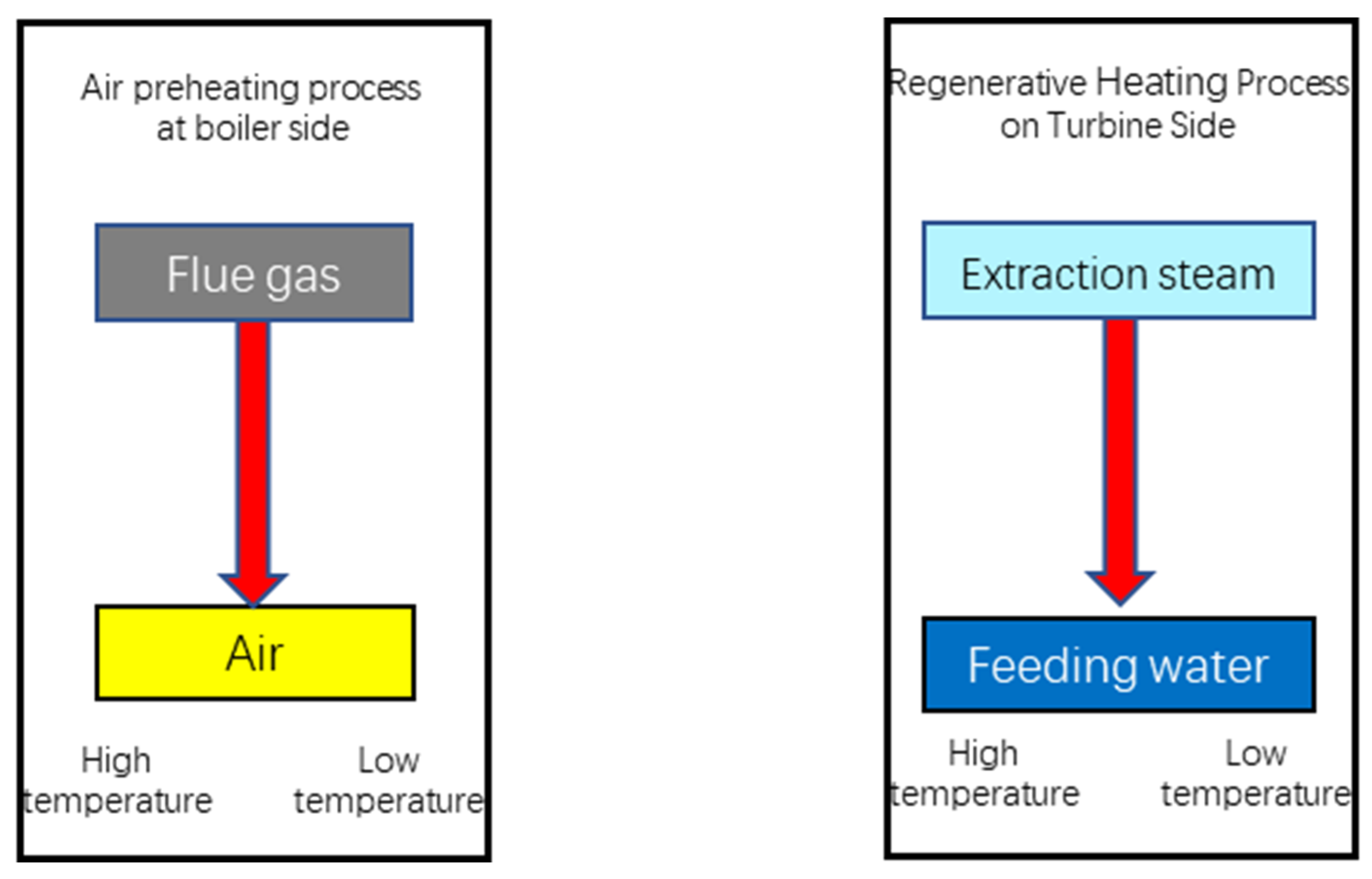


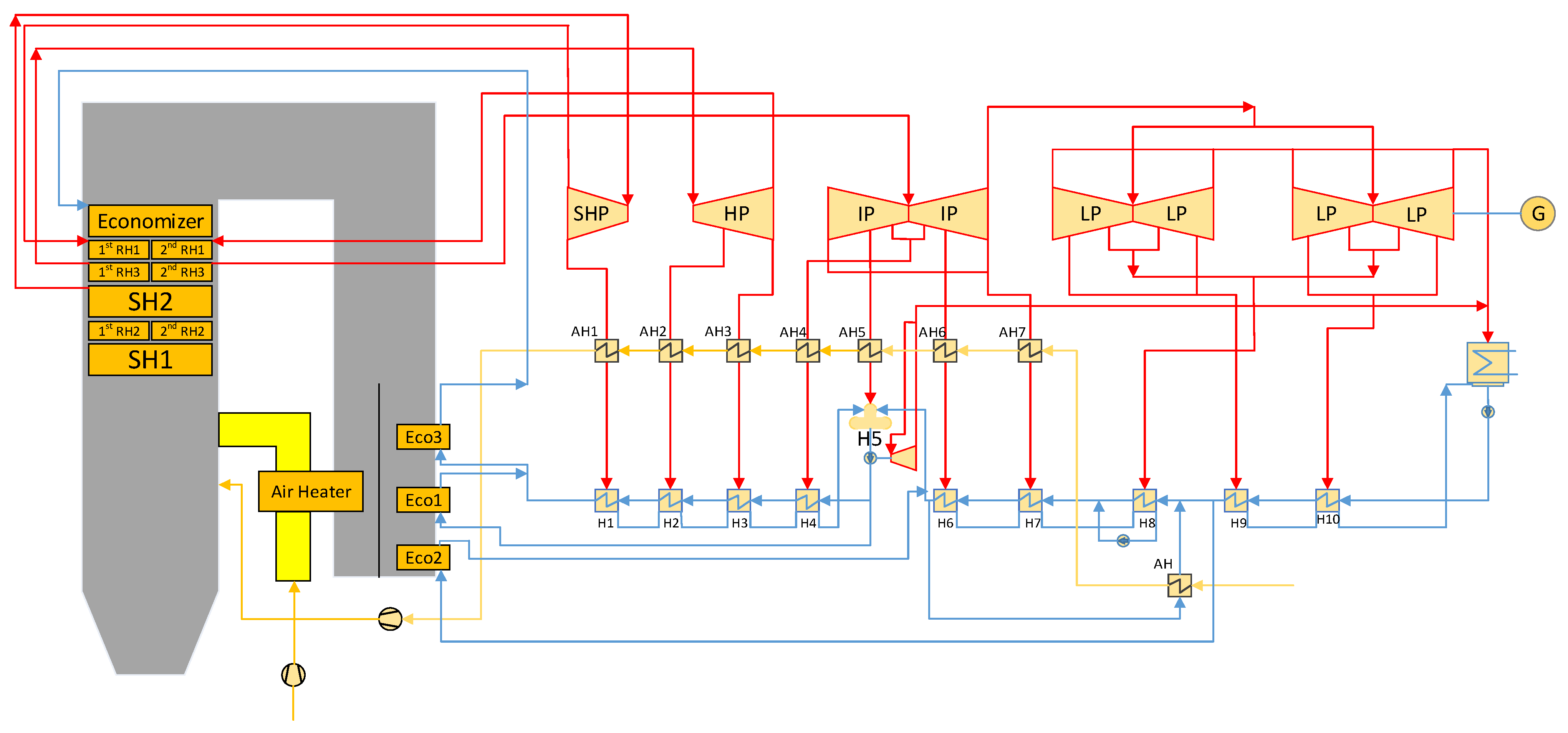

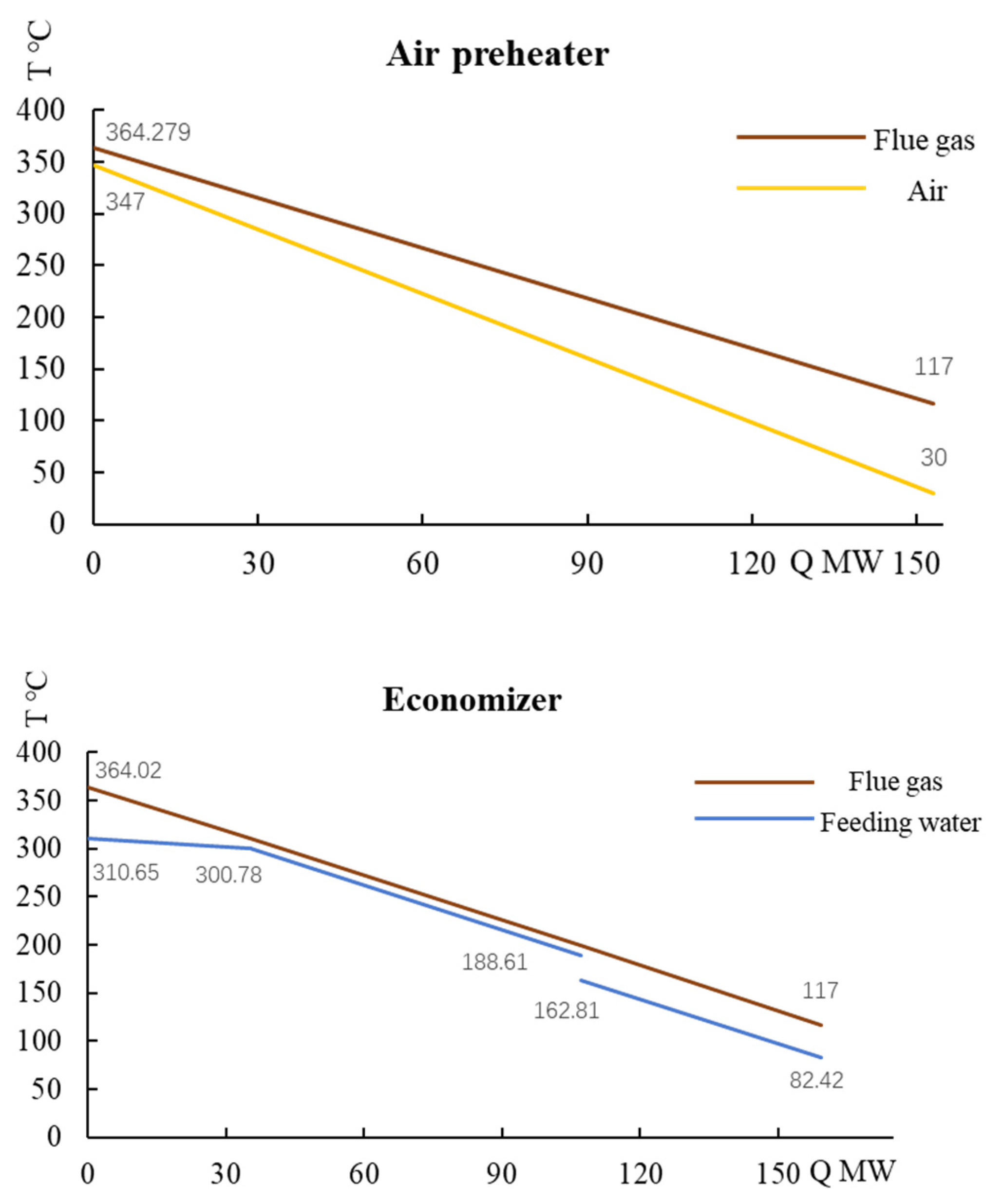
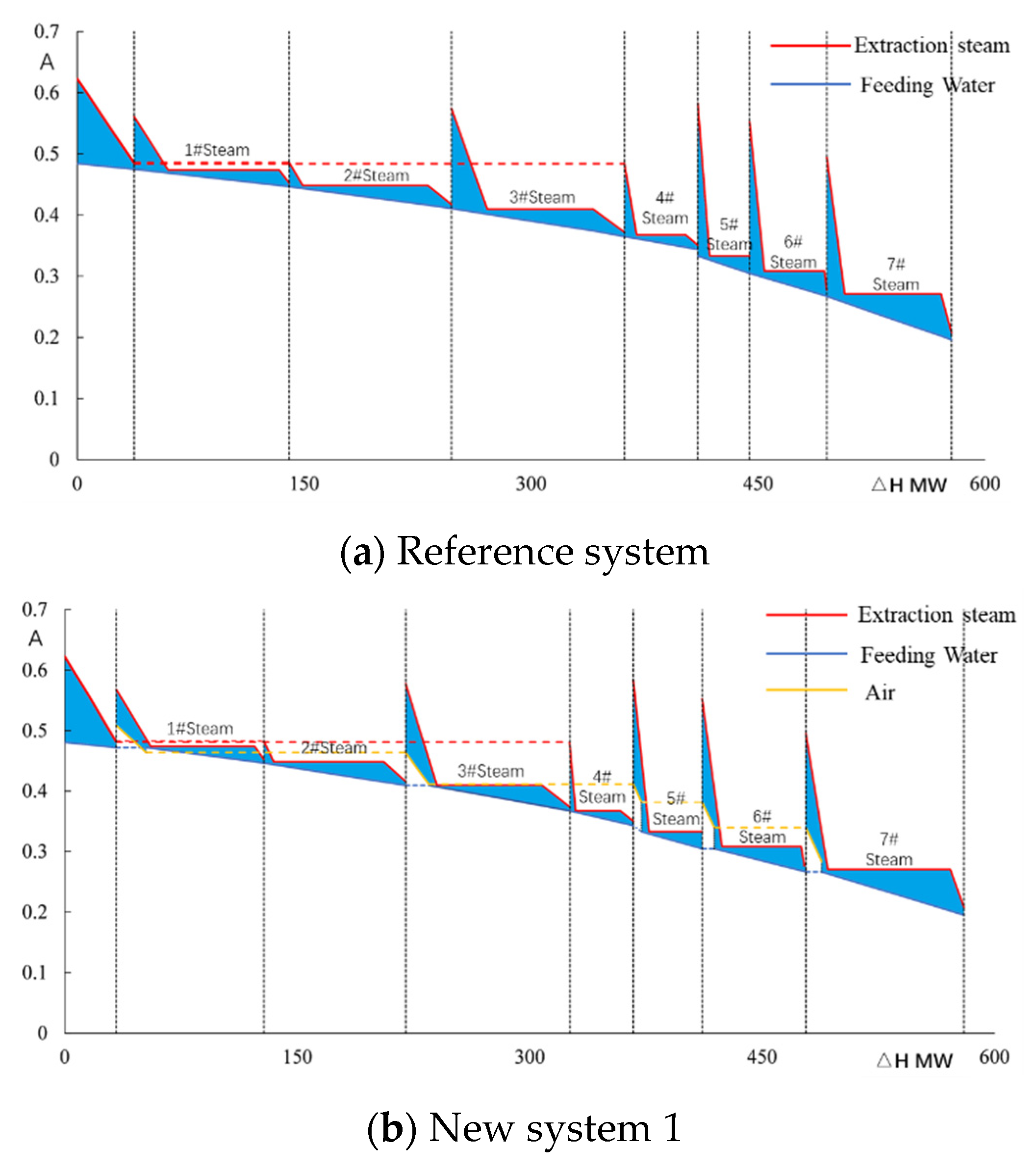






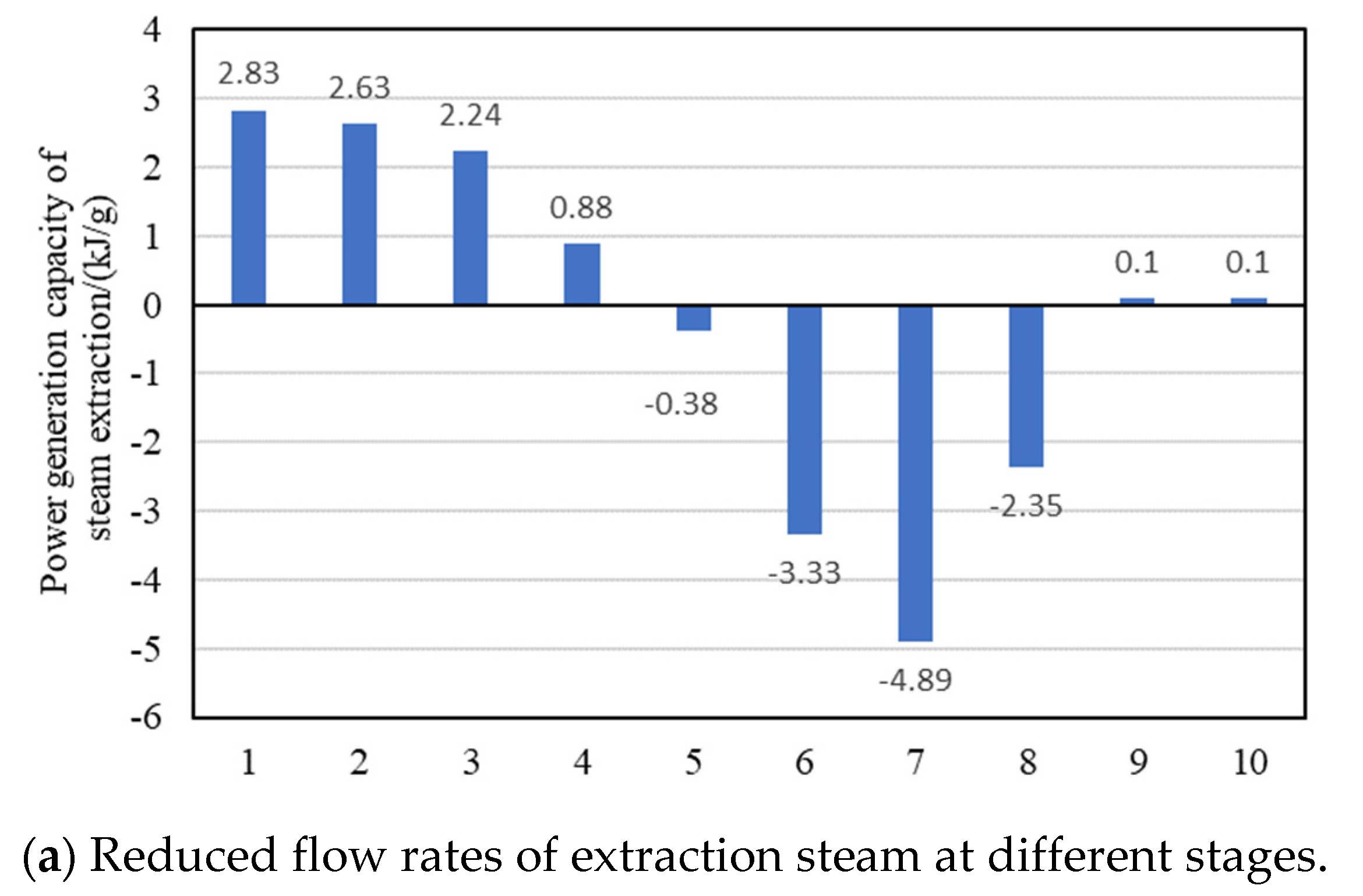
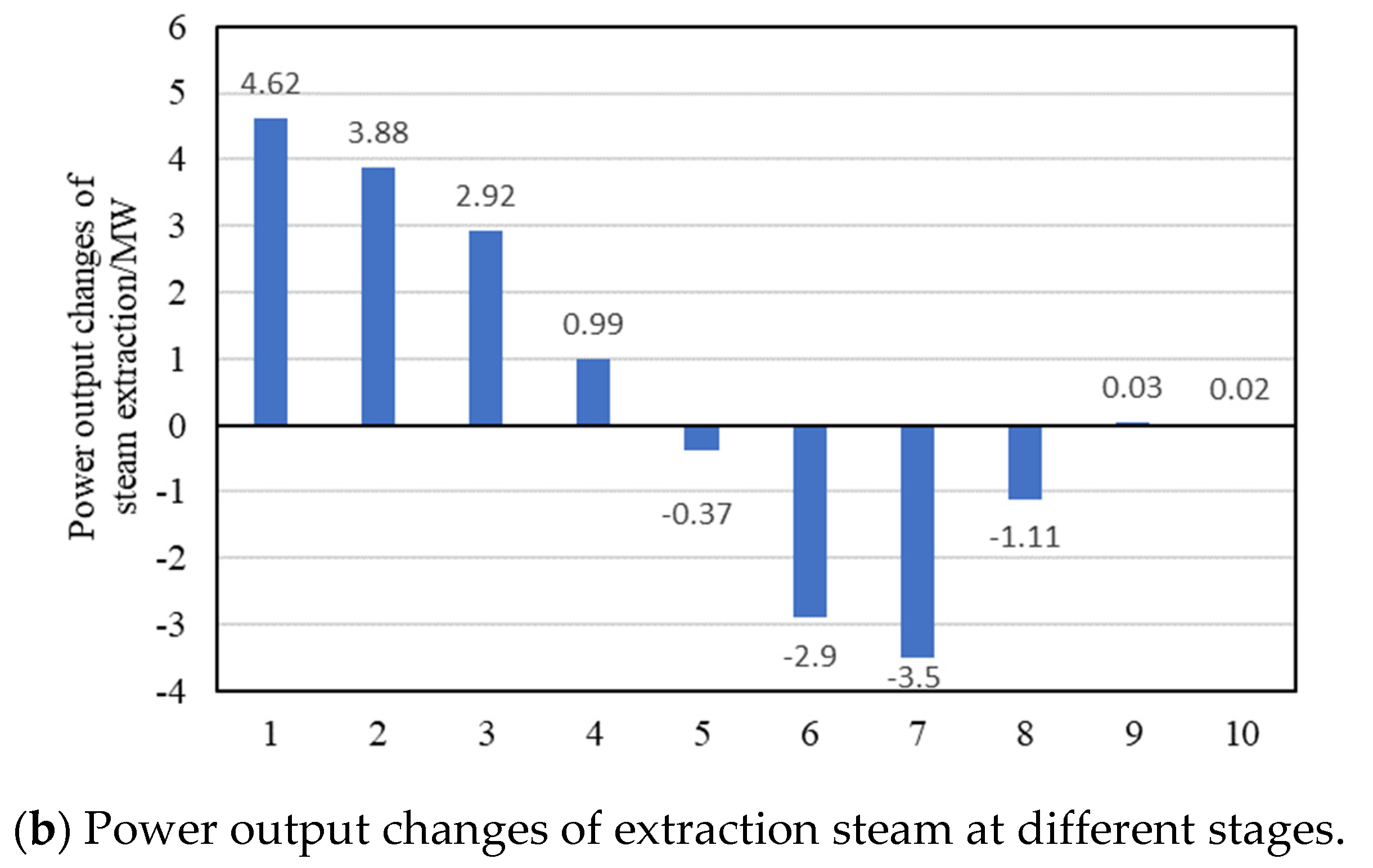

| Element | Mass Fraction/% | |
|---|---|---|
| 1 | Car | 61.7 |
| 2 | Har | 3.67 |
| 3 | Oar | 8.56 |
| 4 | Nar | 1.12 |
| 5 | Sar | 0.6 |
| 6 | Aar | 8.8 |
| 7 | Mar | 15.55 |
| 8 | Vdaf | 34.73 |
| Reference System | New System 1 | New System 2 | |||
|---|---|---|---|---|---|
| Main steam | Mass Flow | t/h | 2533 | 2533 | 2533 |
| Press. | bar | 301 | 301 | 301 | |
| Temp. | °C | 600 | 600 | 600 | |
| Reheat steam | Mass Flow | t/h | 2342 | 2358 | 2365 |
| Press. | bar | 10.1 | 10.1 | 10.1 | |
| Temp. | °C | 610 | 610 | 610 | |
| Double reheat steam | Mass Flow | t/h | 2014 | 2057 | 2068 |
| Press. | bar | 30.8 | 30.8 | 30.8 | |
| Temp. | °C | 610 | 610 | 610 | |
| Coal flow rate | t/h | 319 | 319 | 319 | |
| Air mass flow | t/h | 2948 | 2948 | 2948 | |
| Air heated by the steam extraction | t/h | - | 1252 | 2035 | |
| Total power output | MW | 992.56 | 999.92 | 1001.57 | |
| Power consumption of fans | MW | - | 0.98 | 2.08 | |
| Net output power | MW | 992.56 | 998.94 | 999.49 | |
| Standard coal consumption rate | g/kWh | 257.38 | 255.73 | 255.59 | |
| Reference System | THA | 75% THA | 50% THA | 40% THA | 30% THA | |
|---|---|---|---|---|---|---|
| Main steam flow | t/h | 2533 | 1866.23 | 1211.74 | 971.68 | 738.1 |
| Air flow | t/h | 2947.82 | 2217.91 | 1608.96 | 1478.44 | 1197.33 |
| Flue gas flow | t/h | 3233.58 | 2436.85 | 1759.88 | 1602.73 | 1294.4 |
| Exhaust flue gas temp. | °C | 117.13 | 109.24 | 98.85 | 94.62 | 89.18 |
| Hot air temp. | °C | 347 | 334.78 | 311.23 | 304.05 | 288.13 |
| Total power | MW | 986.79 | 727.14 | 481.07 | 384.52 | 283.85 |
| Coal flow | t/h | 318.49 | 240.01 | 165.48 | 136.29 | 106.43 |
| Standard coal consumption rate | g/kWh | 258.47 | 264.33 | 275.47 | 283.85 | 300.27 |
| New System 1 | THA | 75% THA | 50% THA | 40% THA | 30% THA | |
| Main steam flow | t/h | 2516.39 | 1833.81 | 1189.19 | 959.68 | 731.11 |
| Air flow | t/h | 2927.67 | 2320 | 1718.39 | 1501.91 | 1189.88 |
| Ratio of air heated by steam | % | 42.63 | 42.65 | 37.71 | 37.29 | 38.66 |
| Flue gas flow | t/h | 3216.61 | 2537.57 | 1868.42 | 1625.44 | 1286.34 |
| Bypass flue gas ratio | % | 36.81 | 37.68 | 33.62 | 31.69 | 35.87 |
| Exhaust flue gas temp. | °C | 116.79 | 107.17 | 93.88 | 88.12 | 81.92 |
| Hot air temp. | °C | 346.95 | 333.19 | 305.37 | 294.29 | 276.13 |
| Total power output | MW | 986.78 | 727.14 | 481.07 | 384.52 | 283.85 |
| Fans power consumption | MW | 0.97 | 0.48 | 0.13 | 0.08 | 0.05 |
| Coal flow | t/h | 316.82 | 238.61 | 164.5 | 135.44 | 105.77 |
| Standard coal consumption rate | g/kWh | 257.37 | 262.96 | 273.92 | 282.14 | 298.45 |
| Coal consumption reduction | g/kWh | 1.1 | 1.37 | 1.55 | 1.71 | 1.82 |
| New System 2 | THA | 75% THA | 50% THA | 40% THA | 30% THA | |
| Main steam flow | t/h | 2510.41 | 1832.23 | 1190.27 | 960.47 | 726.96 |
| Air flow | t/h | 2924.15 | 2316.62 | 1718.79 | 1499.7 | 1190.28 |
| ratio of air heated by steam | % | 67.23 | 63.91 | 55.76 | 51.45 | 48.97 |
| Flue gas flow | t/h | 3212.74 | 2533.92 | 1868.85 | 1623.04 | 1286.78 |
| Bypass flue gas ratio | % | 65.78 | 63.1 | 57.12 | 52.09 | 55.35 |
| Exhaust flue gas temp. | °C | 116.86 | 106.12 | 90.44 | 85.33 | 81.29 |
| Hot air temp. | °C | 346.65 | 332.15 | 303.177 | 292.75 | 268.23 |
| Total power output | MW | 986.79 | 727.14 | 481.06 | 384.52 | 283.85 |
| Fans power consumption | MW | 2.03 | 0.87 | 0.25 | 0.12 | 0.07 |
| Coal flow | t/h | 316.44 | 238.26 | 164.54 | 135.24 | 105.81 |
| Standard coal consumption rate | g/kWh | 257.33 | 262.72 | 274.05 | 281.76 | 298.59 |
| Coal consumption reduction | g/kWh | 1.14 | 1.61 | 1.42 | 2.09 | 1.68 |
| New System 1 | New System 3 | |||
|---|---|---|---|---|
| Main steam | Mass Flow | t/h | 2533 | 2533 |
| Press. | bar | 301 | 301 | |
| Temp. | °C | 600 | 600 | |
| 1st reheat steam | Mass Flow | t/h | 2358 | 2368.57 |
| Press. | bar | 10.1 | 10.1 | |
| Temp. | °C | 610 | 610 | |
| 2nd reheat steam | Mass Flow | t/h | 2057 | 2085.02 |
| Press. | bar | 30.8 | 30.8 | |
| Temp. | °C | 610 | 610 | |
| Coal flow | t/h | 319 | 319 | |
| Air flow | t/h | 2948 | 2947.82 | |
| Flow of air heated by steam | t/h | 1252 | 1259.67 | |
| Total power output | MW | 999.92 | 1004.45 | |
| Power consumption of fans | MW | 0.98 | 0.61 | |
| Net output power | MW | 998.94 | 1003.84 | |
| Standard coal consumption rate | g/kWh | 255.73 | 254.48 | |
| New System 3 | THA | 75% THA | 50% THA | 40% THA | 30% THA | |
|---|---|---|---|---|---|---|
| Main steam flow | t/h | 2507.06 | 1823.23 | 1182.16 | 953.66 | 725.37 |
| Air flow | t/h | 2918.34 | 2311.66 | 1715.18 | 1499.91 | 1189.28 |
| Ratio of air heated by steam | % | 42.93 | 44.38 | 49.55 | 52.97 | 48.77 |
| Flue gas flow | t/h | 3206.36 | 2528.49 | 1864.92 | 1623.27 | 1285.7 |
| Bypass flue gas ratio | % | 49.43 | 52.17 | 57.517 | 60.59 | 59.89 |
| Exhaust flue gas temp. | °C | 116.66 | 107.38 | 96.19 | 90.74 | 83.83 |
| Hot air temp. | °C | 346.61 | 328.98 | 297.83 | 285.73 | 262.45 |
| Total power output | MW | 990.96 | 731.1 | 483.95 | 387.96 | 287.41 |
| Fans’ power consumption | MW | 0.6 | 0.33 | 0.18 | 0.15 | 0.05 |
| Coal flow | t/h | 315.81 | 237.75 | 164.19 | 135.26 | 105.72 |
| Standard coal consumption rate | g/kWh | 256.29 | 261.84 | 273.33 | 281.7 | 298.26 |
| Coal consumption rate reduction | g/kWh | 1.08 | 1.12 | 0.59 | 0.44 | 0.19 |
Publisher’s Note: MDPI stays neutral with regard to jurisdictional claims in published maps and institutional affiliations. |
© 2021 by the authors. Licensee MDPI, Basel, Switzerland. This article is an open access article distributed under the terms and conditions of the Creative Commons Attribution (CC BY) license (http://creativecommons.org/licenses/by/4.0/).
Share and Cite
Yang, M.; Duan, L.; Tong, Y. Design and Performance Analysis of New Ultra-Supercritical Double Reheat Coal-Fired Power Generation Systems. Energies 2021, 14, 238. https://doi.org/10.3390/en14010238
Yang M, Duan L, Tong Y. Design and Performance Analysis of New Ultra-Supercritical Double Reheat Coal-Fired Power Generation Systems. Energies. 2021; 14(1):238. https://doi.org/10.3390/en14010238
Chicago/Turabian StyleYang, Ming, Liqiang Duan, and Yongjing Tong. 2021. "Design and Performance Analysis of New Ultra-Supercritical Double Reheat Coal-Fired Power Generation Systems" Energies 14, no. 1: 238. https://doi.org/10.3390/en14010238
APA StyleYang, M., Duan, L., & Tong, Y. (2021). Design and Performance Analysis of New Ultra-Supercritical Double Reheat Coal-Fired Power Generation Systems. Energies, 14(1), 238. https://doi.org/10.3390/en14010238




